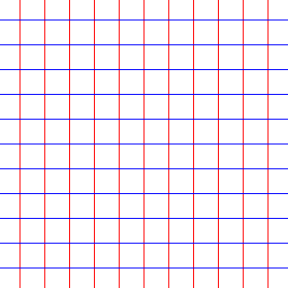| This article may be too technical for most readers to understand. Please help improve it to make it understandable to non-experts, without removing the technical details. (August 2024) (Learn how and when to remove this message) |
In mathematical physics, the conformal symmetry of spacetime is expressed by an extension of the Poincaré group, known as the conformal group; in layman's terms, it refers to the fact that stretching, compressing or otherwise distorting spacetime preserves the angles between lines or curves that exist within spacetime.
Conformal symmetry encompasses special conformal transformations and dilations. In three spatial plus one time dimensions, conformal symmetry has 15 degrees of freedom: ten for the Poincaré group, four for special conformal transformations, and one for a dilation.
Harry Bateman and Ebenezer Cunningham were the first to study the conformal symmetry of Maxwell's equations. They called a generic expression of conformal symmetry a spherical wave transformation. General relativity in two spacetime dimensions also enjoys conformal symmetry.
Generators
The Lie algebra of the conformal group has the following representation:
where are the Lorentz generators, generates translations, generates scaling transformations (also known as dilatations or dilations) and generates the special conformal transformations.
Commutation relations
The commutation relations are as follows:
other commutators vanish. Here is the Minkowski metric tensor.
Additionally, is a scalar and is a covariant vector under the Lorentz transformations.
The special conformal transformations are given by
where is a parameter describing the transformation. This special conformal transformation can also be written as , where
which shows that it consists of an inversion, followed by a translation, followed by a second inversion.


In two-dimensional spacetime, the transformations of the conformal group are the conformal transformations. There are infinitely many of them.
In more than two dimensions, Euclidean conformal transformations map circles to circles, and hyperspheres to hyperspheres with a straight line considered a degenerate circle and a hyperplane a degenerate hypercircle.
In more than two Lorentzian dimensions, conformal transformations map null rays to null rays and light cones to light cones, with a null hyperplane being a degenerate light cone.
Applications
Conformal field theory
Main article: Conformal field theoryIn relativistic quantum field theories, the possibility of symmetries is strictly restricted by Coleman–Mandula theorem under physically reasonable assumptions. The largest possible global symmetry group of a non-supersymmetric interacting field theory is a direct product of the conformal group with an internal group. Such theories are known as conformal field theories.
| This section needs expansion. You can help by adding to it. (March 2017) |
Second-order phase transitions
Main article: phase transitionsOne particular application is to critical phenomena in systems with local interactions. Fluctuations in such systems are conformally invariant at the critical point. That allows for classification of universality classes of phase transitions in terms of conformal field theories.
| This section needs expansion. You can help by adding to it. (March 2017) |
Conformal invariance is also present in two-dimensional turbulence at high Reynolds number.
High-energy physics
Many theories studied in high-energy physics admit conformal symmetry due to it typically being implied by local scale invariance. A famous example is d=4, N=4 supersymmetric Yang–Mills theory due its relevance for AdS/CFT correspondence. Also, the worldsheet in string theory is described by a two-dimensional conformal field theory coupled to two-dimensional gravity.
Mathematical proofs of conformal invariance in lattice models
Physicists have found that many lattice models become conformally invariant in the critical limit. However, mathematical proofs of these results have only appeared much later, and only in some cases.
In 2010, the mathematician Stanislav Smirnov was awarded the Fields medal "for the proof of conformal invariance of percolation and the planar Ising model in statistical physics".
In 2020, the mathematician Hugo Duminil-Copin and his collaborators proved that rotational invariance exists at the boundary between phases in many physical systems.
See also
- Conformal map
- Conformal group
- Coleman–Mandula theorem
- Renormalization group
- Scale invariance
- Superconformal algebra
- Conformal Killing equation
References
- "gravity - What makes General Relativity conformal variant?". Physics Stack Exchange. Retrieved 2020-05-01.
- ^ Di Francesco, Mathieu & Sénéchal 1997, p. 98.
- Di Francesco, Mathieu & Sénéchal 1997, p. 97.
- Juan Maldacena; Alexander Zhiboedov (2013). "Constraining conformal field theories with a higher spin symmetry". Journal of Physics A: Mathematical and Theoretical. 46 (21): 214011. arXiv:1112.1016. Bibcode:2013JPhA...46u4011M. doi:10.1088/1751-8113/46/21/214011. S2CID 56398780.
- Denis Bernard; Guido Boffetta; Antonio Celani; Gregory Falkovich (2006). "Conformal invariance in two-dimensional turbulence". Nature Physics. 2 (2): 124–128. arXiv:nlin/0602017. doi:10.1038/nphys217.
- Rehmeyer, Julie (19 August 2010). "Stanislav Smirnov profile" (PDF). International Congress of Mathematicians. Archived from the original (PDF) on 7 March 2012. Retrieved 19 August 2010.
- "Mathematicians Prove Symmetry of Phase Transitions". Wired. ISSN 1059-1028. Retrieved 2021-07-14.
- Duminil-Copin, Hugo; Kozlowski, Karol Kajetan; Krachun, Dmitry; Manolescu, Ioan; Oulamara, Mendes (2020-12-21). "Rotational invariance in critical planar lattice models". arXiv:2012.11672 .
Sources
- Di Francesco, Philippe; Mathieu, Pierre; Sénéchal, David (1997). Conformal Field Theory. Springer Science & Business Media. ISBN 978-0-387-94785-3.

 are the
are the  generates
generates  generates scaling transformations (also known as dilatations or dilations) and
generates scaling transformations (also known as dilatations or dilations) and  generates the
generates the 
 is the
is the 
 is a parameter describing the transformation. This special conformal transformation can also be written as
is a parameter describing the transformation. This special conformal transformation can also be written as  , where
, where
